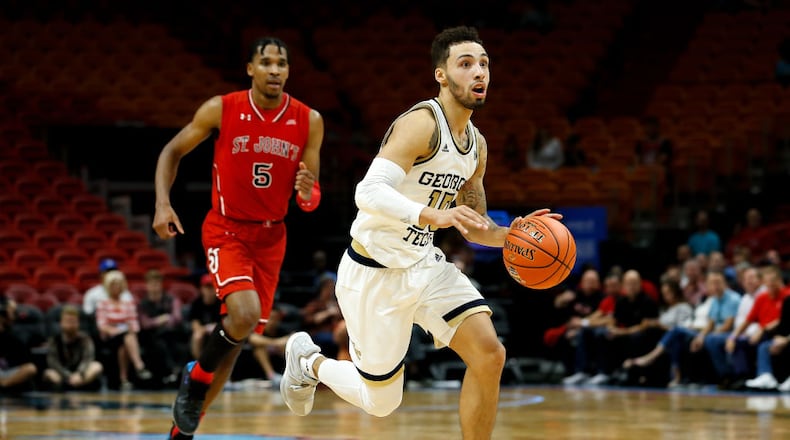With a squadron of perimeter shooters on the roster, Georgia Tech coach Josh Pastner planned to have an attack heavy on 3-point shooting this season. He said in August that he wanted guards Brandon Alston, Jose Alvarado, Michael Devoe, Curtis Haywood and Shembari Phillips all to shoot 43 percent or better from 3-point range.
Pastner has said repeatedly that Tech will live and die with its 3-point shooting. Thus far, the Yellow Jackets’ shooting from beyond the arc has been the wrong kind of lethal more often than they prefer. Tech is 4-3 after seven games, and the Jackets’ 30.7 percentage from beyond the arc actually is lower than their rate from last season (31.8 percent), when Pastner limited 3-point attempts because of the low success rate. The Jackets will try again Sunday against Florida A&M at McCamish Pavilion.
“We haven’t shot to the point where I thought (we would),” Pastner said Friday. “I’ve miscalculated or misjudged, to this point, to right now, because I thought we’d be better shooting based on our percentages.”
Tech has been competitive in its three losses to high-major teams – Tennessee, Northwestern and St. John’s – despite shooting 33 percent or worse in each. Against the Red Storm on Saturday at a neutral-site game in Miami, the Jackets lost 76-73 in a game in which they led by 16 in the second half. Their 3-point shooting was no help – 4-for-21 (19 percent).
One could look at those outcomes and conclude that, if the Jackets could shoot a little better from 3-point range, they could win those games. Or, one could surmise that Tech has played enough games and taken enough 3-pointers that it’s demonstrated what sort of shooting team it is and will be.
Data from last season would indicate that Tech can still recover to be at least an OK 3-point shooting team. Last season, after the games of Dec. 7, 2017, there were 18 teams that were shooting between 30 percent and 30.9 percent (as Tech is at 30.7 percent). Of those 18, five ended the season shooting 35 percent or better, meaning they shot much better than 35 percent the rest of the way. Another five stayed at 31 percent or under.
For the sake of context, the No. 50 team in 3-point accuracy last year shot 37.8 percent and the No. 100 team shot 36.4 percent. No. 150 was 35.5 percent.
Further, Alvarado and Haywood are well under their shooting rates from last season. As freshmen, both shot 37 percent last season. Alvarado is at 28.9 percent and Haywood is at 31.3 percent. Pastner said that the freshman Devoe (30 percent) hasn’t “clicked,” but trusts that, based upon what he has seen in practice, he’ll start finding the range.
“I still believe we’re going to shoot the ball at a high clip,” Pastner said. “We’re going to get going.”
Blind optimism isn’t driving Pastner’s belief. Rather, an inspection of how the Jackets have been shooting since they were unshackled. Pastner believes better shot selection will help. Against St. John’s, for instance, Tech’s shots often were taken from too far away or contested or both. Pastner also said that players are shooting higher than 40 percent on 3-point shots when the ball has been in the paint – a “paint touch” – before coming out to the perimeter.
“Way over 40,” Pastner said. “And we’re in the low 20’s, teens, when we don’t.”
A 3-point attempt off a paint touch has at least two benefits. One, the defense has likely been drawn to the ball away from the perimeter, opening space for shooters. Two, the shooter probably is receiving the ball with his shoulders squared to the basket as opposed to a pass swung from around the perimeter, where he has to turn his shoulders to receive the ball. Pastner said players need to learn the difference in good and bad shots to take.
“We’ve got to play inside-out with our 3’s, getting into the paint – paint touches – kicking out to get our 3’s to get better looks from there,” Pastner said.
Pastner likes what he has seen on defense from the team. Through Thursday’s games, Tech was ranked 17th nationally in adjusted defensive efficiency (KenPom). Post man James Banks, who received an eligibility waiver one game into the season after transferring from Texas, has had double-doubles in his past two games, and his effectiveness should only improve as coaches develop his role after not expecting him to be able to play this season over the offseason. As ever, Tech waits on the offense to produce.
“We haven’t been a good shooting team, but I do believe in our shooting this year,” Pastner said. “I really do.”
About the Author





